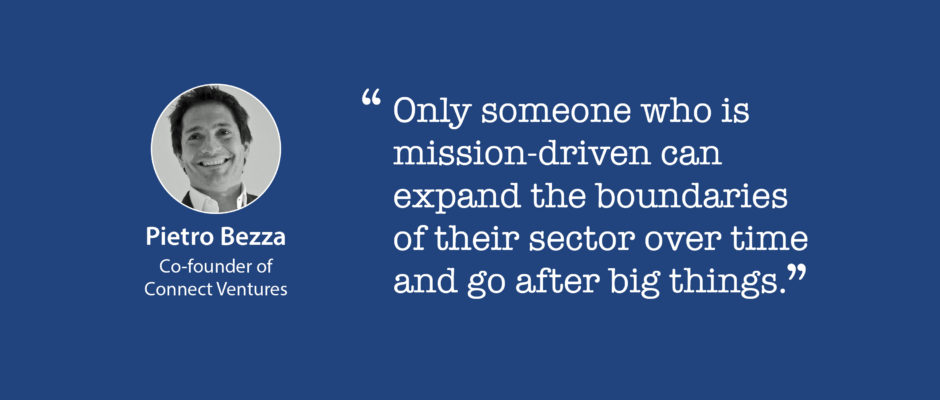Ever wondered what metrics investors really want to see? Or the all-too-common mistakes founders make when pitching their startup? Ed visited the headquarters of Connect Ventures, a London-based VC focusing on early seed-stage investments in the technology space, to speak with Managing Partner Pietro Bezza.
You have the chance to meet Connect Ventures, too. Sitar Teli, a fellow partner, will be at the SaaStock conference in Dublin on September 22, speaking about the SaaS VC landscape in Europe. Don’t miss it!
https://soundcloud.com/chartmogul/pietro-bezza-connect-ventures
Why invest at early stage? It’s all about the product.
Ed: It’s really good to get a SaaS investor perspective. Let’s start at the beginning. I think it makes sense for you to describe what Connect Ventures is and what you guys do as a VC.
Pietro: Yes, it’s something I wonder myself very often, especially when I try to explain my job to my parents or my five-year-old son. For both it’s an issue to get the full picture. So the way I like to think about what I do is to help extraordinary people to extraordinary things. The version for my kid is: “To help superheros turn the impossible to possible.” It works for him.
But it’s true. Because our mission is to help exceptional talents, and you really need incredible personal traits and talented people in tech and design, in creativity. Our role is basically to help. I like the emphasis on the “help” part, because the fact is that venture capital is a service business at core. We provide capital, of course, and advice. But really, especially at Connect, we respect that it’s the founders team that really makes things happen, and our role is to support and to do whatever it takes to make them succeed.
Ed: So you guys focus on early stage investments. My first question is why?
Pietro: To take a step back to explain why we choose early stage — and also why Europe — the foundational vision for Connect Ventures, Sitar Teli, Bill Earner and myself in 2011, the three of us held one strong belief in our minds and our hearts: We really believe in privately-led companies. Because we think, in the end, a technology business is an innovation business. Okay, so I’m confessing my Italian Classics studies, but… “technology” comes from the Greek techne, which means “the art of crafting, to make things better.”
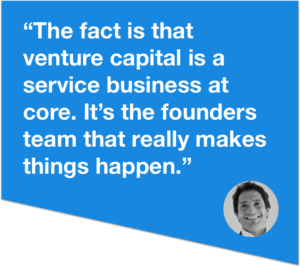 So the technology business at heart, its role, is to make things better through technology, through innovation. And innovation, in the end, is the product. So innovation comes from the product, and the founder can design a better experience. For that reason, we believe products come before the companies. So when we invest, we invest in product.
So the technology business at heart, its role, is to make things better through technology, through innovation. And innovation, in the end, is the product. So innovation comes from the product, and the founder can design a better experience. For that reason, we believe products come before the companies. So when we invest, we invest in product.
Product must be the answer to every strategic puzzle. It should be the foundation of solving the problem the founders want to tackle, but also it should be the answer for growth, for hiring strategy. And it should be the start of the company but also the growth engine. I’m not saying other components aren’t indispensable to building an incredible category winner, like the market, and other functions like sales and marketing, etc. But I think a strong foundation in the DNA of the product is a necessary condition to succeed.
So, the answer to your question. Product innovation is the most hard capability for a company to find. And it’s either something that is in the DNA from day one, or you count it out over time. And it’s this 0 to 1, to Product-Market Fit that happens at seed, where we invest — that’s where you really build the pillars for the company. And that’s why we like to be there.
From founder to investor
Ed: So you yourself have experience growing and leading a business prior to Connect Ventures. Can you explain what you did previously? And if it’s affected your work at Connect in any way?
Pietro: Of course it affects my work at Connect because it must, but I don’t have yet a clear picture of how. I think it’s evolving over time.
Just to give you the background: I had been an operator in marketing and branding for five years, and then at 28 I co-founded Neo Network in Milan. The idea was to bring digital interactive content online. It was the period where TV was dead, “the internet killed the TV,” and everyone gets their shows on demand, which is something that is still true now after fifteen years.
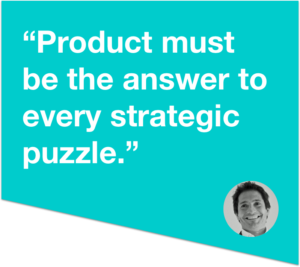 We pivoted a couple times, and we were lucky. We were the right team at the right moment to pivot to mobile. We were very good at designing and building editorial content, and messaging apps, interactive stuff. We started distributing through TELCOs to consumer SMS applications and SMS content. And that was an incredible, booming segment to be in. Together with the UK, Italy and Japan were the leaders. From 2003-2007, was incredible growth — a period of hyper growth — from minus to $40M in revenue. 80 people, very profitable. Then we sold the company to Zodiac media, a big conglomerate in content production.
We pivoted a couple times, and we were lucky. We were the right team at the right moment to pivot to mobile. We were very good at designing and building editorial content, and messaging apps, interactive stuff. We started distributing through TELCOs to consumer SMS applications and SMS content. And that was an incredible, booming segment to be in. Together with the UK, Italy and Japan were the leaders. From 2003-2007, was incredible growth — a period of hyper growth — from minus to $40M in revenue. 80 people, very profitable. Then we sold the company to Zodiac media, a big conglomerate in content production.
Then I stayed three years. I was CEO of the digital unit of this group. After three years at this corporation I realized okay, I definitely want to keep working with startups. The smaller, the better. “Think small” is my mantra. Less is more, simplicity. This goes back to the product.
So from my experience as a founder, mostly what I advise to the founders whom I invest in is to avoid overly fucked up ideas. As a founder myself [and now an investor], I tried also to learn it was a completely different era. Yes we developed apps, but back then it was just about being the first. For example, you were the only dating SMS app. It’s not like it is now, when you go onto app stores and there are 1000 others. So if your product is not 10x better, then you’re not going to exist.
Also my company was European, and we didn’t raise a lot of money. Now instead we are doing the opposite: Product first, and once you get PMF, then accelerate.
So I apply my experience more in management style, how you build the team, how to create a great culture in the company. More on the soft things, but not on the hard things, because my previous company wouldn’t be successful nowadays.
Being solution-oriented and mission-driven
Ed: You also mentioned that you sometimes make decisions based on a team, in the case where a product is not their yet or doesn’t exist yet. Can you tell me some of the qualities you can identify in a team that tell you it’s something that could be successful?
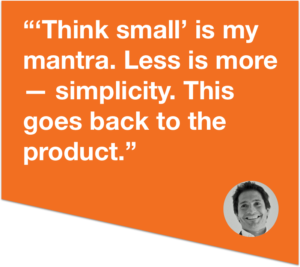 Pietro: Yes. Overall every investor or every firm has a thesis or a style, and basically this criteria changes with a pendulum swinging between Product, Market, and Team. Some put more focus on market, some on product, some on team.
Pietro: Yes. Overall every investor or every firm has a thesis or a style, and basically this criteria changes with a pendulum swinging between Product, Market, and Team. Some put more focus on market, some on product, some on team.
Of course the team must be exceptional. But based on your VC style, the team could have a different relevancy. For us, the most important thing is that the founders or the team are mission-led or mission-driven. The most important question we ask is: “Why are you doing this?” What’s your purpose? Why are you spending ten years of your life and giving up other things for this?
And when the answer is, “Because I think running a startup is cool; because I have an idea to do my own startup,” these are red flags for us. We really want to back people who don’t want to build a company — maybe they hate building companies! — but they couldn’t live without solving the problem they’re facing everyday. There wasn’t any solution they liked on the market so they say, “You know what, I’ll just create a better version for this problem.” Reinventing and reimagining something that could solve their problem. So when someone says, “Oh, I’ve been working and this has been my pet project for one year,” we say: “Great. In this case you really want to solve the problem and not build the company.”
We call this Founder-Market Fit, technically — but it’s not just domain expertise. Because often we back dropouts. There are 22 or 23 year olds, so they have zero domain expertise in terms of professional knowledge of the sector or the network of people.
They know nothing about the market players. Instead they have incredible insight into that specific problem.
And I can give you a lot of examples of that. We just invested in a company in France, basically a marketplace for students to find great temporary jobs at companies. The four founders are four students who have been through the struggle of trying to find a job during their studies. So they said, “Why don’t we create a platform where someone selects the best students and the best companies and does the matchmaking?” They know nothing about the employment market because they are students, but they are students, so they totally have good insight into what you need to be served well in this market, with this target audience.
There are too many reasons why we choose to invest in mission-driven companies:
- These people are solution driven, so they come with a product. The answer to the problem is designing and building a product. There’s no other way to tackle it. And again, we think the product is innovation and the way to the business, not vice versa. Being invested in mission driven founders is key for that.
- If you are really tied to your market or your category and you work for a purpose, then you will always be in it for the long run. You’re not going to be a flake. You’re not thinking “I see an opportunity, I want to seize it, I’ll build something and then I’m going to flake by selling it after two years.”
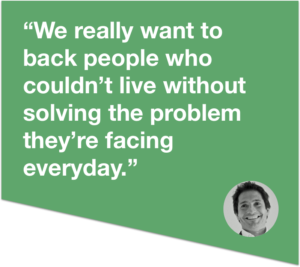 Our seed fund is small, but our second fund is 50M pounds. It’s big enough that we need to be part of a big company; we’re investing for it to become a highly valuable company over time. So we need to partner with founders that can stay ten years and build big companies. And only someone who is mission-driven can expand the boundaries of his sector over time and go after big things. Innovation is very quick in cycles, and so if you’re not a product person, you can’t really re-innovate at the next technology change.
Our seed fund is small, but our second fund is 50M pounds. It’s big enough that we need to be part of a big company; we’re investing for it to become a highly valuable company over time. So we need to partner with founders that can stay ten years and build big companies. And only someone who is mission-driven can expand the boundaries of his sector over time and go after big things. Innovation is very quick in cycles, and so if you’re not a product person, you can’t really re-innovate at the next technology change.
Thats why we really, really, really — I can’t stress this more — why we stand by founder/CEO. We think that overtime, the CEO must be the founders. Because they imagined the company for the first time, they had the idea of the product. They created something out of nothing. So, when the first solution is no longer buyable, they can just reimagine again, without panicking. If you come to a company as CEO and the company has already grown, and then something changes, you panic and think, “Okay this isn’t going to last forever.”
Founders are very good at creating, maybe not the best at maximizing something. But today we see technology companies keep surfing on all the changes. And only someone who really has a bond with the market, who can reimagine a product solution with great UX — that’s the key.
The founder attributes important to Connect Ventures
Ed: So basically you’re arguing that the founder is the best equipped person to innovate.
Pietro: It’s by definition. Because again, the founder must be a learnable person. A product is not sufficient condition to succeed. A problem-centric, founder-mission founder is not in a sufficient condition to succeed.
Of course once they build a product, they have to build a company. And they have to understand how to run a company. That’s a big thing! It’s about: organization, culture, communication, growth, money. And so the other attribute we really want to see is how learnable you are. That doesn’t mean that you shouldn’t be incredibly strongly opinionated. Because if you are on a mission, you really have to fight for your opinion. But you also have to be coachable and you have to listen.
So the “strong opinions loosely held” kind of person is our ideal. We are totally fine if they are tractable or if they are difficult. There are founders we really like to work with because they are so open and so nice, and you also have great founders who you should work with… it takes a bit of your passion, let’s say, to work with them. But it’s incredibly rewarding anyway.
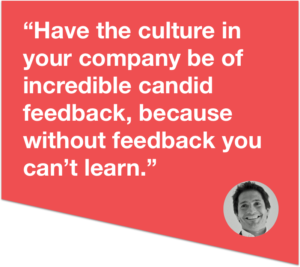 They must be learnable, they must learn over time how to build things. And also stay dedicated to something. That is about the transition from a product person to a great company CEO.
They must be learnable, they must learn over time how to build things. And also stay dedicated to something. That is about the transition from a product person to a great company CEO.
Ed: Do you think founders can learn those skills, or is this something that’s deeply rooted in people?
Pietro: I think you can learn everything, pretty much. You have to want to learn. And you can learn how to learn! You have to have a mindset hungry for learning and you also have to apply and execute action to stay in a learnable position. For example, asking for feedback. Have the communication clear in your company. Have the culture in your company be of incredible candid feedback, because without feedback you can’t learn. You need this loop.
You can learn how to be learnable over time. Also you need to understand your strengths and weaknesses. And once you learn that, you can focus on the things you’re good at and delegate the others.
The SaaS metrics important to Connect Ventures
Ed: I’m also interested to know about the flipside of the people stuff. There obviously comes a time when you need to measure and evaluate a business. You’re looking at a lot of pitchdecks and monitoring the business you’ve invested in. What are some of the key metrics or compass metrics that you like to see, that give you a good indicator?
Pietro: I’m a big fan of the ChartMogul product, for SaaS, because it provides me with an immediate picture of how healthy is the business. Diving into the SaaS businesses, there are two metrics or criteria that I personally focus on. I’ll split it to pre-investment and after investment.
One is “engagement.” And this varies from product to product, but for example — it could be a quantity measurement or a quality measurement, or both. For Typeform, it’s how many Typeforms a specific organization has created and distributed over time. That’s just about quantity. Of course you want to see the quality. You want to see how many people have completed a Typeform, too.
After investment we stay for series A or B, so the company starts growing. This is where ChartMogul comes into play. I think MRR doesn’t lie. You can break down everything, get conclusions, break down the dynamics. In the end, MRR doesn’t lie. It encapsulates everything — what’s the ARPA? What’s your ability to expand with a certain customer and add an upsell? And on the negative, it shows your ability to retain your customers and where you have unhealthy churn.
So definitely, after the investment, to evaluate the health of the business, MRR is the big important thing that we look at. MRR and all the movements.
I’m not a big fan of CAC/LTV, because it’s very subjective. The way you define CAC and define LTV is a bit arbitrary and, for sure, I don’t care about it as investment criteria. Because I don’t have time to figure out how the metric is defined or built, and the founders optimize it for [funding rounds] anyway. Instead, once we are in the company, and we have much better access inside and understanding, then it is something we track.
If you’d like to learn more about the SaaS metrics mentioned above, check out the Ultimate SaaS Metrics Cheat Sheet.
Monitoring metrics and finding something exceptional
Ed: Are there any big mistakes you see people making with metrics? Either at the pre-investment stage or post investment? Is there anything you see that’s instantly a red flag for you?
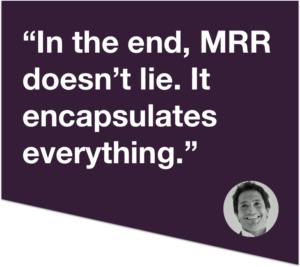 Pietro: One mistake I did was to focus on MRR statically, without looking at how much MRR you’ve added in the last two or three months. It really matters where you see acceleration, deceleration. In under $50k MRR SaaS business, it can look the same as one with $150k MRR — it means nothing. What matters is how long it took you to get to that point; what’s your velocity? And if you can grow the MRR new business very quickly and efficiently, but there is also a big churn… Churn compounds, new business doesn’t. So the mistake could be just seeing “$40K MRR,” a big splash on the screen that tells you nothing. It tells you the cash in for the next month, but it doesn’t tell you if there is something exceptional.
Pietro: One mistake I did was to focus on MRR statically, without looking at how much MRR you’ve added in the last two or three months. It really matters where you see acceleration, deceleration. In under $50k MRR SaaS business, it can look the same as one with $150k MRR — it means nothing. What matters is how long it took you to get to that point; what’s your velocity? And if you can grow the MRR new business very quickly and efficiently, but there is also a big churn… Churn compounds, new business doesn’t. So the mistake could be just seeing “$40K MRR,” a big splash on the screen that tells you nothing. It tells you the cash in for the next month, but it doesn’t tell you if there is something exceptional.
And personally, the way I invest, I need something exceptional. I don’t need fifteen good things. I need fourteen disaster things and something phenomenal. And this [phenomenal thing] could be a founder’s attribute, or a specific feature of the product or of the company.
Ed: Do you have any examples of those?
Pietro: Sure. Typeform. There were a lot of good things and a lot of bad things, we invested so early. Entire pieces of the organization were not there. And some investors may see that and say, “Well why would you invest? They don’t have this and this.” We are totally fine with that. We want to see some incredible, actionable element.
So with Typeform, one was founder’s attribute. They are designer geniuses. The solution they had in their heads and how they executed it is phenomenal. In its simplicity, it is incredible. They didn’t invent anything; forms and surveys have been around for years. But what they did do was make them sexy, make them fun, and make them conversional. And the public vision on this is incredible. So we think that adding extraordinary design and user experience talent, in the market and category where Typeform wanted to be, is pivotal.
Ed: Awesome. Thanks very much. It’s been great to chat.
Pietro: Thank you, it’s been a pleasure.
